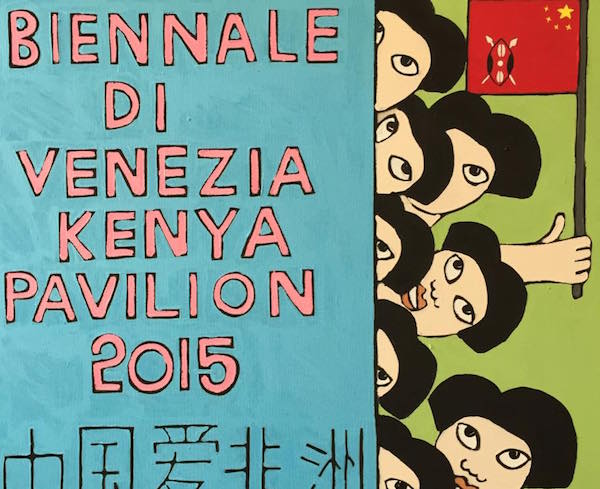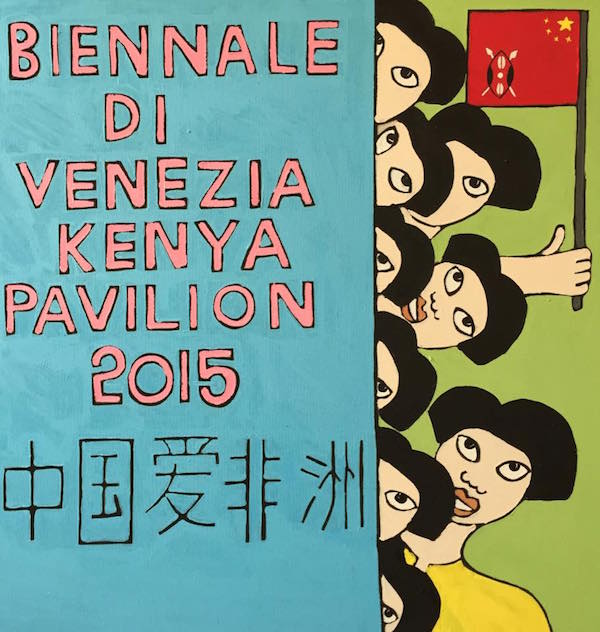Art & Exhibitions
“Shame in Venice”: Italian-Chinese Line-up for Kenya’s Biennale Pavilion Sparks Outrage
Kenya is heading for yet another curatorial disaster.

Photo via: Facebook
Kenya is heading for yet another curatorial disaster.


Michael Soi, The shame in Venice 1 (2015)
Photo via: Facebook
For the second time in the history of the nation, Kenya will have its own pavilion at the Venice Biennale. But, with a couple of Italian curators at the helm and only one Kenyan artist participating in a group dominated by Chinese and Italian artists, the Kenyan art scene is protesting, rather than celebrating, Daily Nation reports.
“The Kenya pavilion at the 2015 Biennale is a total outrage, same as the 2013 one,” Lavinia Calza, director of ARTLabAfrica, one of the biggest commercial galleries in Nairobi, told artnet News. “I can’t see a positive angle anywhere.”
A petition titled “Renounce Kenya’s fraudulent representation at the 56th Venice Biennial 2015 and commit to support the realisation of a national pavilion in 2017” has been launched on change.org.
The 2015 Pavilion Replicates the Disastrous Kenyan Debut at the 2013 Biennale
Commissioned by an Italian citizen, Paola Poponi (of whom no curatorial record pre-Venice can be found online), and curated by Sandro Orlandi and herself, the Kenyan National Pavilion at the Venice Biannale debuted in 2013 with a group show, somewhat patronizingly entitled “Reflective Nature: a new primary enchanting sensitivity.”
Of the 12 participating artists—Kivuthi Mbuno, Armando Tanzini, Chrispus Wangombe Wachira, Fan Bo, Luo Ling & Liu Ke, Lu Peng, Li Wei, He Weiming, Chen Wenling, Feng Zhengjie, and César Meneghetti—only two were from Kenya: Mbuno and Wachira. The majority were Chinese. The show was unanimously panned, with one critic dubbing the whole affair “neocolonialism as multiculturalism.”
Back in June 2013, Manuel Toledo, from BBC Africa wrote: “According to Zimbabwe’s curator, Raphael Chikukwa, none of his Kenyan colleagues had even heard about the show. […] One of the members of this year’s biennale’s jury, Nigerian curator and artistic director of the Centre for Contemporary Art, Lagos, Bisi Silva, agreed that the large Chinese presence was ‘peculiar’.”
“The Kenyan pavilion is apparently a huge flop with the work being thought to be of poor artistic quality,” wrote Mwende Ngao in an article entitled Why are Chinese artists representing Kenya at the Venice Biennale? “It is quite an embarrassment for Kenya as a nation as it is after all, a national pavilion and anything that happens there is believed to be sanctioned by Kenya and a representation of Kenyan art.”
Did Kenya sell its art scene to China via Italy?
The participation of Kenya in the upcoming 2015 Venice Biennale will follow a similar pattern. The pavilion will be again commissioned by Poponi, curated by the same team, and feature a line-up of mostly Chinese artists, with the exception of one Kenyan, Yvonne Apiyo Braendle-Amolo, and one Italian, Armando Tanzini, whose work was also shown in the 2013 pavilion.
Many are now asking: “did Kenya sell its art scene to China via Italy?”
The Kenyan-born, London-based artist Phoebe Boswell is particularly suspicious of Tanzini’s continued presence. Writing for Africa is a Country, she says:
“How has an Italian hotelier, albeit one who has long-standing ties to Malindi, managed to take over the Kenyan Pavilion at the 2015 Venice Biennale? Armando Tanzini has lived on the Kenya coast for 45 years, and has made a lot of ‘stuff’, from carved driftwood elephants, to baobab trees, to beach villas, to bad collages made from “found materials” – including green flip-flops – in the shape of the African continent. I will grant him the fact that he is known as much for this as he is for mingling with wealthy Italians who holiday in Malindi. However, he is entirely disconnected from the contemporary Kenyan art and culture scene, and has not been known to attempt to get to know Kenyan artists, let alone to represent them.”
Meanwhile, the Kenyan artist Michael Soi has created a series of satirical paintings entitled “The shame in Venice” (2015) in response to the controversy, and perhaps also to the Chinese stronghold on the African continent.

Michael Soi, The shame in Venice 2 (2015)
Photo via: Facebook
Other African Pavilions Have Excelled in Venice
While it has become common for national pavilions to pick artists from other nations—the British Liam Gillick representing Germany in 2009, or the Israeli Yael Bartana representing Poland in 2011 are only two of many examples—the Poponi-curated pavilion seems, at the very least, like a huge missed opportunity for a Kenyan art scene that has had limited exposure on the global art circuit so far.
This pavilion also puts into sharp relief the arbitrariness of national representations at the Venice biennale, which appear to have more to do with whoever has money to put on the table rather than with finding the most appropriate curators for the job.
Considering the brio with which other African pavilions have debuted in Venice (with Angola winning the Golden Lion for Best National Participation in 2013), it’s easy to understand why Kenyans are feeling disappointed and excluded.
“The problem is there is no political will at government level to change the situation, and governmental support for the arts in Kenya is dismal,” ARTLabAfrica’s Calza told artnet News.
Check out a video of recent coverage of the affair at NTV Kenya: